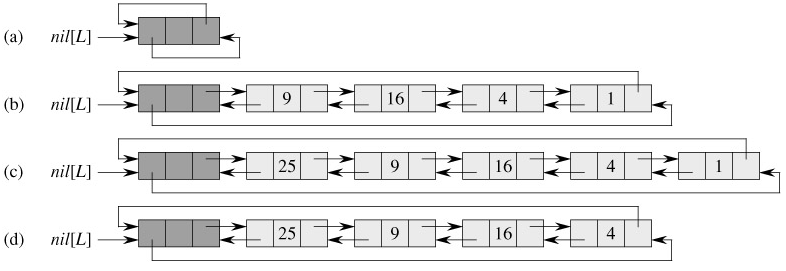SKEDSOFT
Sentinels: The code for LIST-DELETE would be simpler if we could ignore the boundary conditions at the head and tail of the list.
LIST-DELET′ (L, x) 1 next[prev[x]] ← next[x] 2 prev[next[x]] ← prev[x]
A sentinel is a dummy object that allows us to simplify boundary conditions. For example, suppose that we provide with list L an object nil[L] that represents NIL but has all the fields of the other list elements. Wherever we have a reference to NIL in list code, we replace it by a reference to the sentinel nil[L]. As shown in Figure 10.4, this turns a regular doubly linked list into a circular, doubly linked list with a sentinel, in which the sentinel nil[L] is placed between the head and tail; the field next[nil[L]] points to the head of the list, and prev[nil[L]] points to the tail. Similarly, both the next field of the tail and the prev field of the head point to nil[L]. Since next[nil[L]] points to the head, we can eliminate the attribute head[L] altogether, replacing references to it by references to next[nil[L]]. An empty list consists of just the sentinel, since both next[nil[L]] and prev[nil[L]] can be set to nil[L].

The code for LIST-SEARCH remains the same as before, but with the references to NIL and head[L] changed as specified above.
LIST-SEARC′(L, k) 1 x ← next[nil[L]] 2 while x ≠ nil[L] and key[x] ≠ k 3 do x ← next[x] 4 return x
We use the two-line procedure LIST-DELET′ to delete an element from the list. We use the following procedure to insert an element into the list.
LIST-INSER′ (L, x) 1 next[x] ← next[nil[L]] 2 prev[next[nil[L]]] ← x 3 next[nil[L]] ← x 4 prev[x] ← nil[L]
Figure 10.4 shows the effects of LIST-INSER′ and LIST-DELET′ on a sample list.
Sentinels rarely reduce the asymptotic time bounds of data structure operations, but they can reduce constant factors. The gain from using sentinels within loops is usually a matter of clarity of code rather than speed; the linked list code, for example, is simplified by the use of sentinels, but we save only O(1) time in the LIST-INSER′ and LIST-DELET′ procedures. In other situations, however, the use of sentinels helps to tighten the code in a loop, thus reducing the coefficient of, say, n or n2 in the running time.
Sentinels should not be used indiscriminately. If there are many small lists, the extra storage used by their sentinels can represent significant wasted memory. In this book, we use sentinels only when they truly simplify the code.